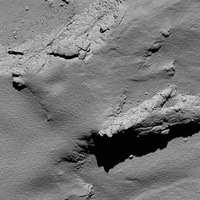COBS News archive
Close Approach Comets
April 22, 2017
Comets are some of the most interesting objects in the solar system. Water that filled the ancient oceans of Earth might have been delivered by comets. And there is growing evidence that many comets (as well as some primitive asteroids) contain molecules key to life. NASA has sent space probes to travel hundreds of millions of miles to study these icy interlopers from the outer solar system.
Comet 67P full of surprises: Growing fractures, collapsing cliffs and rolling boulders
March 27, 2017
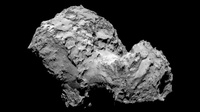
New CCD photometry software keys added
March 09, 2017
Bright outburst of Comet 73P fragment
February 12, 2017
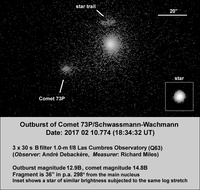
Thierry Noel has reported that Comet 73P/Schwassmann-Wachmann is showing a second component in images taken remotely from Chile (Observers: A. Maury, B. Sandness, T. Noel). Follow-up images taken by Andre Debackere using the Las Cumbres Observatory 1.0-m telescope at Siding Spring, Australia and measured by Richard Miles show that the main comet is accompanied by a much brighter secondary component surrounded by a faint coma.
Massive comet-like object pollutes atmosphere of a white dwarf
February 10, 2017
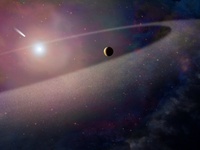
For the first time, scientists using NASA's Hubble Space Telescope have witnessed a massive object with the makeup of a comet being ripped apart and scattered in the atmosphere of a white dwarf, the burned-out remains of a compact star. The object has a chemical composition similar to Halley's Comet, but it is 100,000 times more massive and has a much higher amount of water. It is also rich in the elements essential for life, including nitrogen, carbon, oxygen, and sulfur.
Micro spacecraft investigates cometary water mystery
January 30, 2017
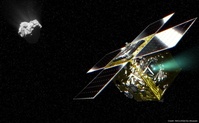
In September 2015, a team of astronomers successfully observed the entire hydrogen coma of the comet 67P/Churyumov-Gerasimenko, using the LAICA telescope onboard the PROCYON spacecraft. They also succeeded in obtaining the absolute rate of water discharge from the comet. Through our observations, we were able to test the coma models for the comet for the first time. This result is the first scientific achievement by a micro spacecraft for deep space exploration.
New Comet: C/2017 A3 (Elenin)
January 12, 2017
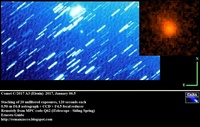
Hubble detects 'exocomets' taking the plunge into a young star
January 09, 2017
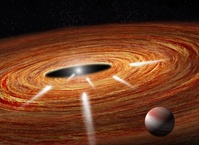
Relationships between chemicals found on comets
December 05, 2016
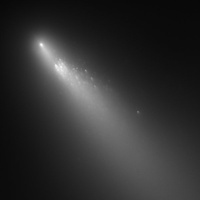
A new study has revealed similarities and relationships between certain types of chemicals found on 30 different comets, which vary widely in their overall composition compared to one another. The research is part of ongoing investigations into these primordial bodies, which contain material largely unchanged from the birth of the solar system some 4.6 billion years ago.
Comet Chury is much younger than previously thought
November 12, 2016
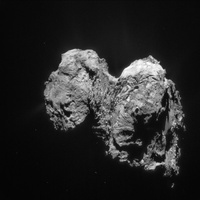
Based on computer simulations, Astrophysicists at the University of Bern, Switzerland, conclude that the comet Chury did not obtain its duck-like form during the formation of our solar system 4.5 billion years ago. Although it does contain primordial material, they are able to show that the comet in its present form is hardly more than a billion years old.
Astronomers predict possible birthplace of Rosetta-probed comet 67P
October 19, 2016
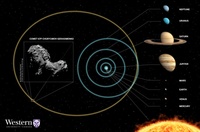
When the Rosetta spacecraft successfully touched down on comet 67P/Churyumov-Gerasimenko on September 30, 2016, the news was shared globally via Twitter in dozens of languages. Citizens the world over were engaged by the astronomical achievement, and now experts are eager to learn as much as possible about the critically important celestial body of ice.
Klim Churyumov (1937-2016)
October 18, 2016

A note to CCD observers - kphot review
October 16, 2016
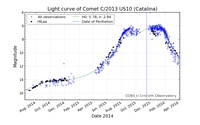
It’s been several years that a new method of processing CCD observations was announced by german astronomer Uwe Pilz. The method was a promising way for amateur astronomers, to generate a visual equivalent magnitude using a CCD measures with a very simple way of processing. Now after several years, there were several observers which were using this method, one of most active was Kevin Hills from United Kingdom. The huge amount of his observations made possible a deep comparative analysis of this method with visual and classic CCD magnitudes.
CometWatch from Kepler
October 08, 2016
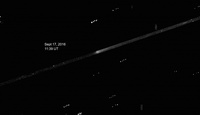
During the last month of Rosetta's operations at Comet 67P/Churyumov-Gerasimenko, it was no longer possible to observe the comet with telescopes on Earth because it was not far from the Sun's position in the sky and therefore not visible in the night-time. Fortunately, NASA's Kepler space observatory stepped in, taking images of the comet every 30 minutes from 7 to 20 September, providing important context to Rosetta's in situ measurements.
Loss of signal confirmation
October 08, 2016
Mission Complete
October 08, 2016
Rosetta’s landing site
October 08, 2016
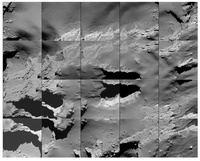
Comet landing: Rosetta’s last image
October 08, 2016
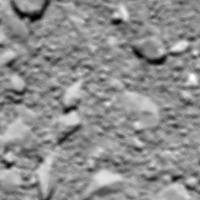
Comet landing descent image – 1.2 km
October 08, 2016
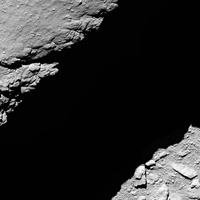
Comet landing descent image – 5.7 km
October 08, 2016
